Climate Change Decreased Net Ecosystem Productivity in the Arid Region of Central Asia
Abstract
:1. Introduction
2. Materials and Methods
2.1. Study Area
2.2. Data
2.3. NPP Estimation
2.4. NEP Estimation
2.5. Theil-Sen Median Trend Analysis and Mann-Kendall Test
2.6. Sensitivity Analysis
3. Results
3.1. Spatio-Temporal Variation Characteristics of NEP
3.2. Response of NEP to Climate Factors
3.3. Effect of Drought on Carbon Source/Sink Relationship
4. Discussion
4.1. Data Uncertainty Analysis
4.2. Relationships among NPP, RH, NEP, and Land Cover
4.3. Future Trends in NEP in Central Asia
5. Conclusions
- (1)
- In terms of the interannual variation, the annual NPP trend of Central Asia from 2001 to 2019 was not significant, the RH increased significantly, and the NEP decreased significantly. Spatially, areas where the NPP and RH increased significantly were larger than those where the NPP decreased significantly, and the areas where the NEP decreased significantly were larger than those where the NPP increased significantly. Regions where the NPP increased significantly were mainly in eastern and southern Central Asia. Regions where the NPP decreased significantly were mainly in the west. Regions where the RH increased significantly were concentrated in the west and southwest, and regions where the RH decreased almost passed the significance test. The areas where the NEP decreased significantly were mainly distributed in the west and south. The NEP showed a significant upward trend only in a small area.
- (2)
- In terms of climate sensitivity, the NPP was more sensitive to precipitation, which increased with increasing precipitation in most regions. The RH was more sensitive to temperature and increased with increasing temperature. However, the NEP was more sensitive to temperature than precipitation and decreased with increasing temperature.
- (3)
- From 2001 to 2019, the contribution rate of temperature to the NEP was larger than that of precipitation, mainly manifested as the acceleration of soil respiration caused by the increasing temperature. A large amount of carbon was emitted to the atmosphere through soil respiration, resulting in the reduction of the carbon sink in the ecosystem.
- (4)
- Drought also has an important impact on the carbon source/sink in Central Asia. Drought from 2001 to 2008 led to a significant increase in the area of carbon sources in Central Asia, with a weak carbon sink transforming into a carbon source and a weak carbon source transforming into a strong carbon source.
Author Contributions
Funding
Data Availability Statement
Conflicts of Interest
References
- Alexander, L.; Allen, S.; Bindoff, N.; Breon, F.-M.; Church, J.; Cubasch, U.; Emori, S.; Forster, P.; Friedlingstein, P.; Gillett, N.; et al. Climate change 2013: The physical science basis, in contribution of Working Group I (WGI) to the Fifth Assessment Report (AR5) of the Intergovernmental Panel on Climate Change (IPCC). Science 2013, 129, 83–103. [Google Scholar]
- Hiltner, U.; Huth, A.; Hérault, B.; Holtmann, A.; Bräuning, A.; Fischer, R. Climate change alters the ability of neotropical forests to provide timber and sequester carbon. For. Ecol. Manag. 2021, 492, 119166. [Google Scholar] [CrossRef]
- Zhang, W.; Zhou, T.; Zou, L.; Zhang, L.; Chen, X. Reduced exposure to extreme precipitation from 0.5 °C less warming in global land monsoon regions. Nat. Commun. 2018, 9, 3153. [Google Scholar] [CrossRef] [Green Version]
- Zhang, L.; Wylie, B.K.; Ji, L.; Gilmanov, T.G.; Tieszen, L.L.; Howard, D.M. Upscaling carbon fluxes over the Great Plains grasslands: Sinks and sources. J. Geophys. Res. 2011, 116, 1–13. [Google Scholar]
- Li, Z.; Chen, Y.; Zhang, Q.; Li, Y. Spatial patterns of vegetation carbon sinks and sources under water constraint in Central Asia. J. Hydrol. 2020, 590, 125355. [Google Scholar] [CrossRef]
- Keenan, T.F.; Prentice, I.C.; Canadell, J.; Williams, C.A.; Wang, H.; Raupach, M.; Collatz, G.J. Recent pause in the growth rate of atmospheric CO2 due to enhanced terrestrial carbon uptake. Nat. Commun. 2016, 7, 13428. [Google Scholar] [CrossRef] [PubMed] [Green Version]
- Cui, E.; Bian, C.; Luo, Y.; Niu, S.; Wang, Y.; Xia, J. Spatial variations in terrestrial net ecosystem productivity and its local indicators. Biogeosciences 2020, 17, 6237–6246. [Google Scholar] [CrossRef]
- Hassan, Q.K.; Bourque, C.P.-A.; Meng, F.-R. Estimation of daytime net ecosystem CO2 exchange over balsam fir forests in eastern Canada: Combining averaged tower-based flux measurements with remotely sensed MODIS data. Can. J. Remote Sens. 2006, 32, 405–416. [Google Scholar] [CrossRef] [Green Version]
- Li, C.; Wang, Y.; Wu, X.; Cao, H.; Li, W.; Wu, T. Reducing human activity promotes environmental restoration in arid and semi-arid regions: A case study in Northwest China. Sci. Total Environ. 2021, 768. [Google Scholar] [CrossRef] [PubMed]
- Hashimoto, S.; Carvalhais, N.; Ito, A.; Migliavacca, M.; Nishina, K.; Reichstein, M. Global spatiotemporal distribution of soil respiration modeled using a global database. Biogeosciences 2015, 12, 4121–4132. [Google Scholar] [CrossRef] [Green Version]
- Mitchard, E.T.A. The tropical forest carbon cycle and climate change. Nature 2018, 559, 527–534. [Google Scholar] [CrossRef]
- Piao, S.; Ciais, P.; Friedlingstein, P.; Peylin, P.; Reichstein, M.; Luyssaert, S.; A Margolis, H.; Fang, J.; Barr, A.; Chen, A.; et al. Net carbon dioxide losses of northern ecosystems in response to autumn warming. Nature 2008, 451, 49–52. [Google Scholar] [CrossRef]
- Yang, Y.; Fang, J.; Ma, W.; Smith, P.; Mohammat, A.; Wang, S.; Wang, W. Soil carbon stock and its changes in northern China’s grasslands from 1980s to 2000s. Glob. Chang. Biol. 2010, 16, 3036–3047. [Google Scholar] [CrossRef]
- Yao, Y.; Li, Z.; Wang, T.; Chen, A.; Wang, X.; Du, M.; Jia, G.; Li, Y.; Li, H.; Luo, W.; et al. A new estimation of China’s net ecosystem productivity based on eddy covariance measurements and a model tree ensemble approach. Agric. For. Meteorol. 2018, 253, 84–93. [Google Scholar] [CrossRef]
- Cao, M.; Prince, S.D.; Li, K.; Tao, B.; Small, J.; Shao, X. Response of terrestrial carbon uptake to climate interannual variability in China. Glob. Chang. Biol. 2003, 9, 536–546. [Google Scholar] [CrossRef]
- Pei, Z.-Y.; Ouyang, H.; Zhou, C.-P.; Xu, X. Carbon Balance in an Alpine Steppe in the Qinghai-Tibet Plateau. J. Integr. Plant Biol. 2009, 51, 521–526. [Google Scholar] [CrossRef]
- Jie, G.; Ying, Z.; Caiyun, Q. Temporal and spatial distribution of net ecosystem productivity in the Bailongjiang Watershed of Gansu Province. Acta Ecol. Sin. 2017, 37, 5121–5128. [Google Scholar]
- Hu, Z.; Zhang, C.; Hu, Q.; Tian, H. Temperature Changes in Central Asia from 1979 to 2011 Based on Multiple Datasets. J. Clim. 2014, 27, 1143–1167. [Google Scholar] [CrossRef]
- Wu, L.; Ma, X.; Dou, X.; Zhu, J.; Zhao, C. Impacts of climate change on vegetation phenology and net primary productivity in arid Central Asia. Sci. Total Environ. 2021, 796, 149055. [Google Scholar] [CrossRef]
- Yao, J.; Chen, Y.; Chen, J.; Zhao, Y.; Tuoliewubieke, D.; Li, J.; Yang, L.; Mao, W. Intensification of extreme precipitation in arid Central Asia. J. Hydrol. 2021, 598, 125760. [Google Scholar] [CrossRef]
- Li, Z.; Chen, Y.; Fang, G.; Li, Y. Multivariate assessment and attribution of droughts in Central Asia. Sci. Rep. 2017, 7, 1–12. [Google Scholar] [CrossRef] [PubMed]
- Li, C.; Zhang, C.; Luo, G.; Chen, X.; Maisupova, B.; Madaminov, A.A.; Han, Q.; Djenbaev, B.M. Carbon stock and its responses to climate change in Central Asia. Glob. Chang. Biol. 2015, 21, 1951–1967. [Google Scholar] [CrossRef] [PubMed]
- Han, Q.; Luo, G.; Li, C.; Li, S. Response of Carbon Dynamics to Climate Change Varied among Different Vegetation Types in Central Asia. Sustainability 2018, 10, 3288. [Google Scholar] [CrossRef] [Green Version]
- Han, Q.; Luo, G.; Li, C.; Shakir, A.; Wu, M.; Saidov, A. Simulated grazing effects on carbon emission in Central Asia. Agric. For. Meteorol. 2016, 216, 203–214. [Google Scholar] [CrossRef]
- Han, Q.; Yan, L.; Li, C. Impact of climate change on grassland carbon cycling in Central Asia. Arid Land Geogr. 2018, 41, 1351–1357. [Google Scholar]
- Sala, O.E.; Jackson, R.B.; Mooney, H.A.; Howarth, R.W. Introduction. Methods in Ecosystem Science: Progress, Tradeoffs, and Limitations. In Methods in Ecosystem Science; Springer: New York, NY, USA, 2000; pp. 1–3. [Google Scholar]
- Potter, C.S.; Randerson, J.T.; Field, C.B.; Matson, P.A.; Vitousek, P.M.; Mooney, H.A.; Klooster, S.A. Terrestrial ecosystem production: A process model based on global satellite and surface data. Glob. Biogeochem. Cycles 1993, 7, 811–841. [Google Scholar] [CrossRef]
- Zhu, W.; Pan, Y.; He, H.; Yu, D.; Hu, H. Simulation of maximum light use efficiency for some typical vegetation types in China. Chin. Sci. Bull. 2006, 51, 457–463. [Google Scholar] [CrossRef]
- Jiang, W.; Yuan, L.; Wang, W.; Cao, R.; Zhang, Y.; Shen, W. Spatio-temporal analysis of vegetation variation in the Yellow River Basin. Ecol. Indic. 2015, 51, 117–126. [Google Scholar] [CrossRef]
- Pan, N.; Feng, X.; Fu, B.; Wang, S.; Ji, F.; Pan, S. Increasing global vegetation browning hidden in overall vegetation greening: Insights from time-varying trends. Remote Sens. Environ. 2018, 214, 59–72. [Google Scholar] [CrossRef]
- Li, Z.; Chen, Y.; Li, W.; Deng, H.; Fang, G. Potential impacts of climate change on vegetation dynamics in Central Asia. J. Geophys. Res. Atmos. 2015, 120, 12345–12356. [Google Scholar] [CrossRef]
- Dai, E.F.; Huang, Y.; Wu, Z.; Zhao, D.S. Analysis of spatio-temporal features of a carbon source/sink and its relationship to climatic factors in the Inner Mongolia grassland ecosystem. Acta Geogr. Sin. 2016, 26, 297–312. [Google Scholar] [CrossRef] [Green Version]
- Houghton, R.A. Revised estimates of the annual net flux of carbon to the atmosphere from changes in land use and land management 1850–2000. Tellus B Chem. Phys. Meteorol. 2016, 55, 378–390. [Google Scholar]
- Tang, Y.; Jia, C.; Wang, L.; Wen, X.; Wang, H. Solar energy dominates and soil water modulates net ecosystem productivity and evapotranspiration across multiple timescales in a subtropical coniferous plantation. Agric. For. Meteorol. 2021, 300, 108310. [Google Scholar] [CrossRef]
- Chen, B.; Zhang, X.; Tao, J.; Wu, J.; Wang, J.; Shi, P.; Zhang, Y.; Yu, C. The impact of climate change and anthropogenic activities on alpine grassland over the Qinghai-Tibet Plateau. Agric. For. Meteorol. 2014, 189–190, 11–18. [Google Scholar] [CrossRef]
- Matías, L.; Hidalgo-Galvez, M.D.; Cambrollé, J.; Domínguez, M.T.; Pérez-Ramos, I.M. How will forecasted warming and drought affect soil respiration in savannah ecosystems? The role of tree canopy and grazing legacy. Agric. For. Meteorol. 2021, 304–305, 108425. [Google Scholar] [CrossRef]
- Chen, D.; Zhang, C.; Wu, J.; Zhou, L.; Lin, Y.; Fu, S. Subtropical plantations are large carbon sinks: Evidence from two monoculture plantations in South China. Agric. For. Meteorol. 2011, 151, 1214–1225. [Google Scholar] [CrossRef]
- Neumann, M.; Zhao, M.; Kindermann, G.; Hasenauer, H. Comparing MODIS Net Primary Production Estimates with Terrestrial National Forest Inventory Data in Austria. Remote Sens. 2015, 7, 3878–3906. [Google Scholar] [CrossRef] [Green Version]
- Wei, L. Spatiotemporal Change Research of Ecosystems Productivity in Regions of Central Asia Based on Improved BEPS Model 2019; Henan Polytechnic University: Jiaozuo, China, 2019. [Google Scholar]
- Ferdush, J.; Paul, V. A review on the possible factors influencing soil inorganic carbon under elevated CO2. Catena 2021, 204. [Google Scholar] [CrossRef]
- De Keersmaecker, W.; Lhermitte, S.; Tits, L.; Honnay, O.; Somers, B.; Coppin, P. A model quantifying global vegetation resistance and resilience to short-term climate anomalies and their relationship with vegetation cover. Glob. Ecol. Biogeogr. 2015, 24, 539–548. [Google Scholar] [CrossRef]
- Zhou, P.; Liu, G.; Xue, S. Review of soil respiration and the impact factors on grassland ecosystem. Acta Prataculturae Sin. 2009, 18, 184–193. [Google Scholar]
- Kou, D.; Ma, W.; Ding, J.; Zhang, B.; Fang, K.; Hu, H.; Yu, J.; Wang, T.; Qin, S.; Zhao, X.; et al. Dryland soils in northern China sequester carbon during the early 2000s warming hiatus period. Funct. Ecol. 2018, 32, 1620–1630. [Google Scholar] [CrossRef]
- Dalal, R.C.; Thornton, C.M.; Allen, D.E.; Kopittke, P.M. A study over 33 years shows that carbon and nitrogen stocks in a subtropical soil are increasing under native vegetation in a changing climate. Sci. Total Environ. 2021, 772, 145019. [Google Scholar] [CrossRef]
- Cramer, W.; Bondeau, A.; Woodward, F.I.; Prentice, I.C.; Betts, R.A.; Brovkin, V.; Cox, P.M.; Fisher, V.; Foley, J.A.; Friend, A.D.; et al. Global response of terrestrial ecosystem structure and function to CO2 and climate change: Results from six dynamic global vegetation models. Glob. Chang. Biol. 2001, 7, 357–373. [Google Scholar] [CrossRef] [Green Version]
- Zhou, L.; Wang, Y.; Jia, Q.; Zhou, G. Increasing temperature shortened the carbon uptake period and decreased the cumulative net ecosystem productivity in a maize cropland in Northeast China. Field Crops Res. 2021, 267, 108150. [Google Scholar] [CrossRef]
- Lloyd, J.; Taylor, J. On the Temperature Dependence of Soil Respiration. Funct. Ecol. 1994, 8, 315–323. [Google Scholar] [CrossRef]
- Zhang, J.; Wang, F. Regional Temperature Response in Central Asia to National Committed Emission Reductions. Int. J. Environ. Res. Public Health 2019, 16, 2661. [Google Scholar] [CrossRef] [Green Version]
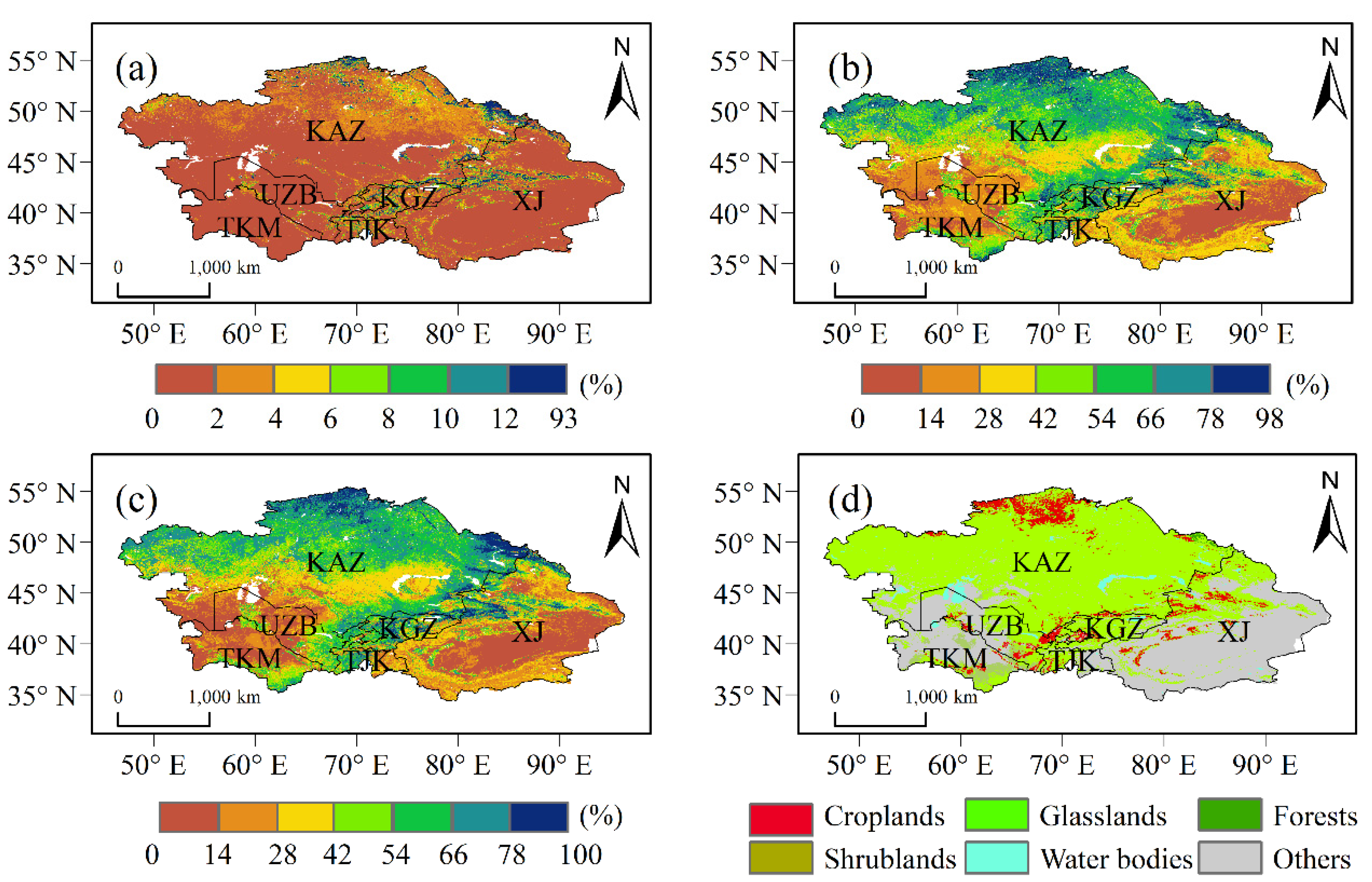
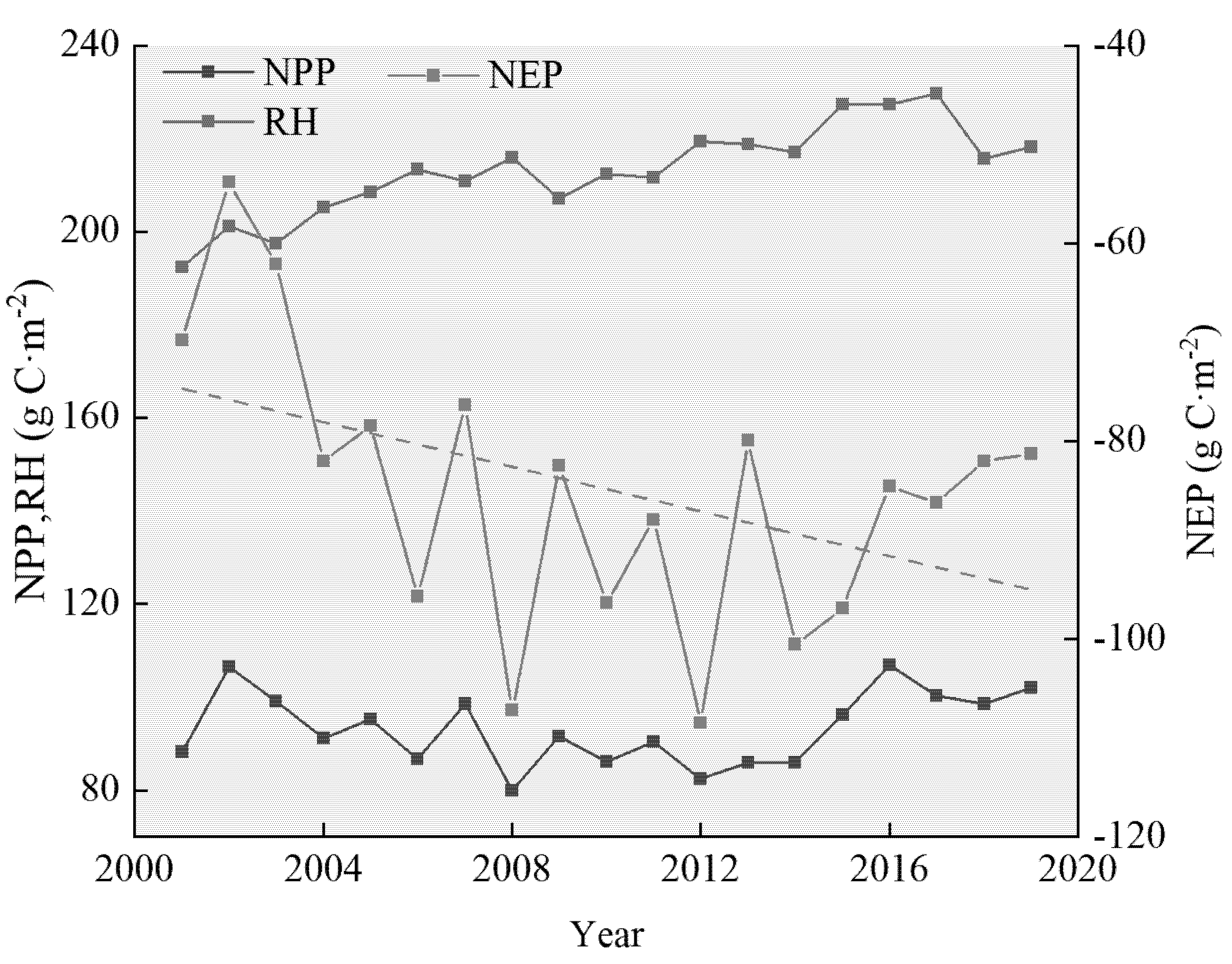
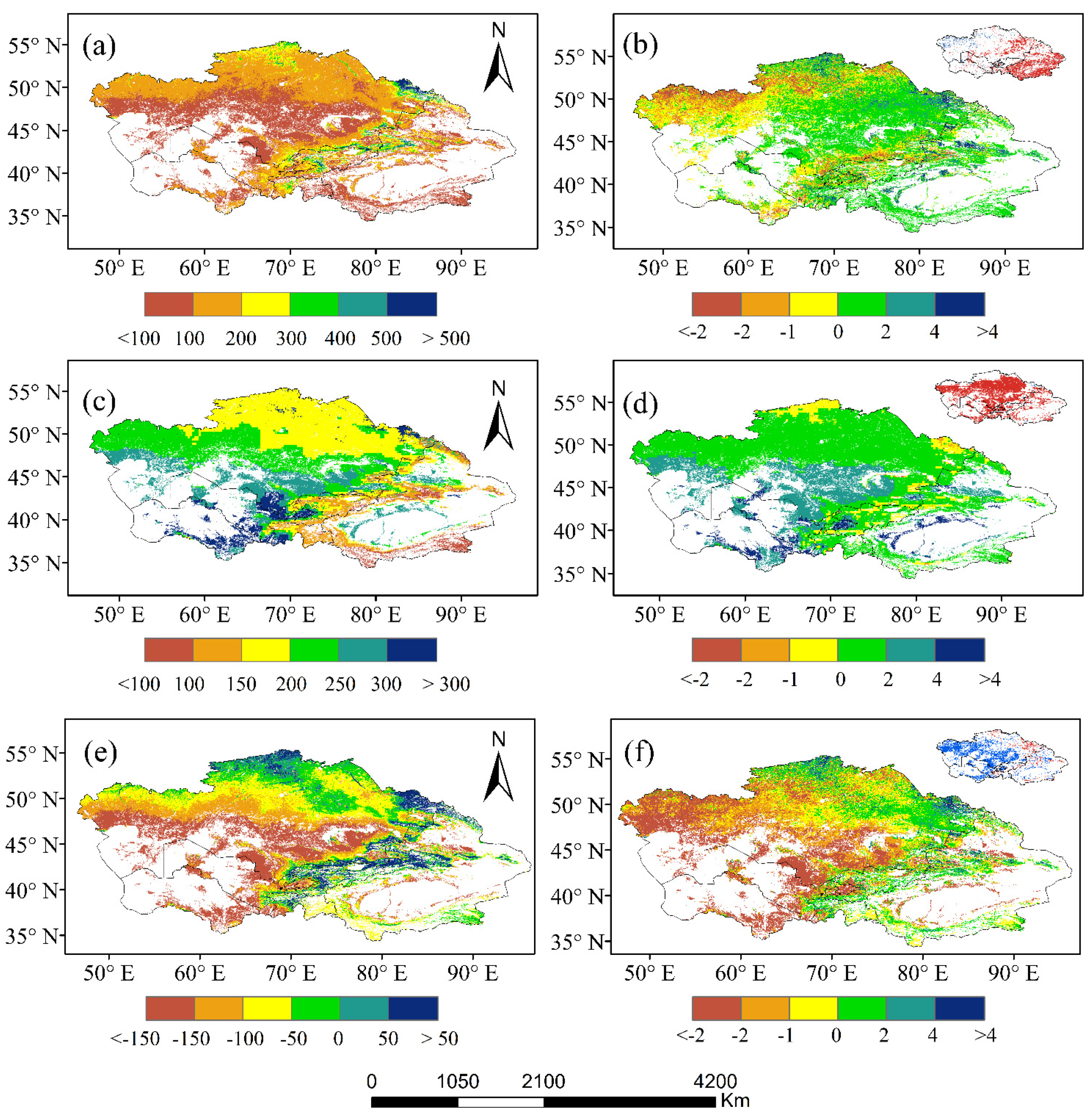
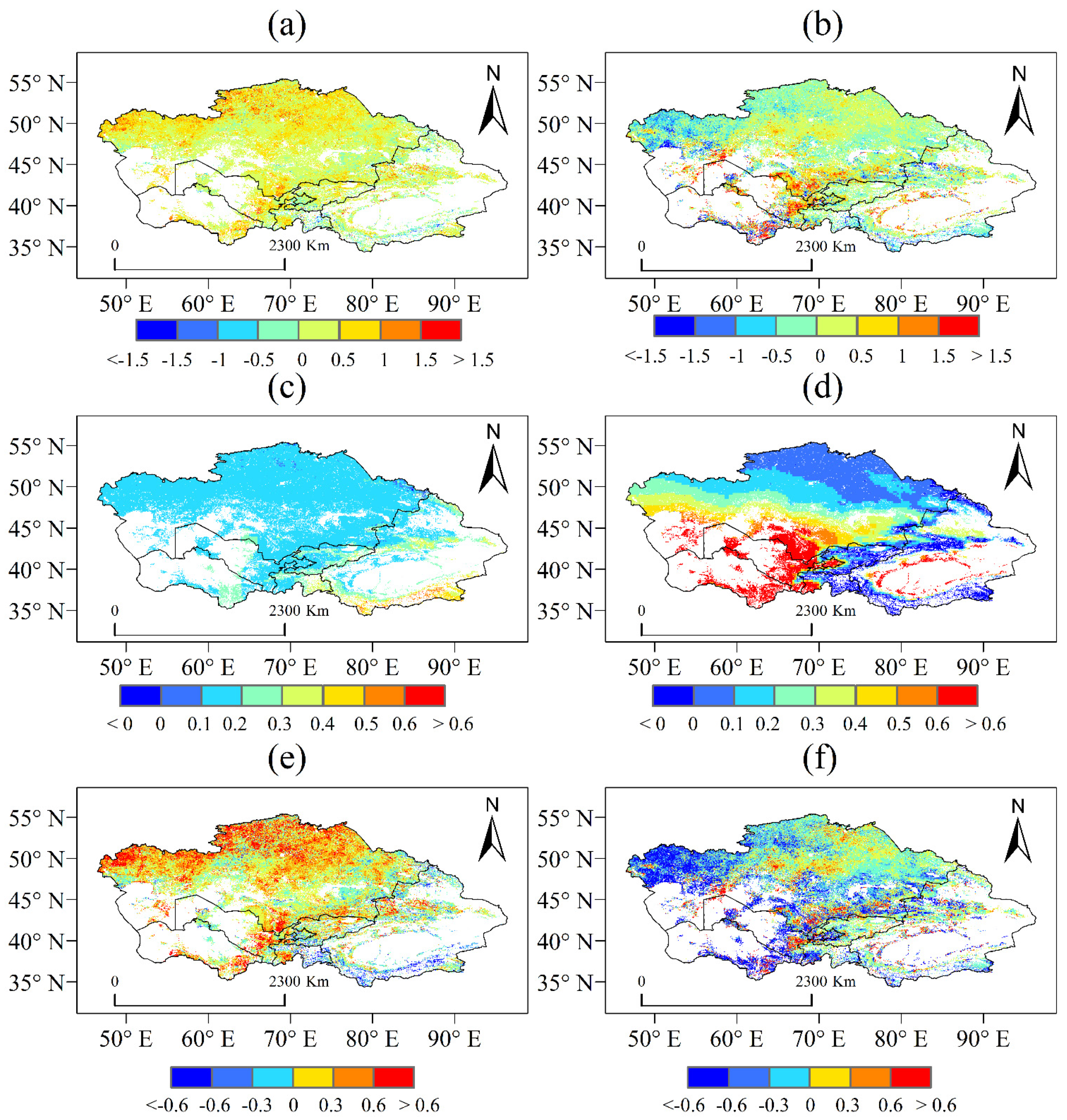


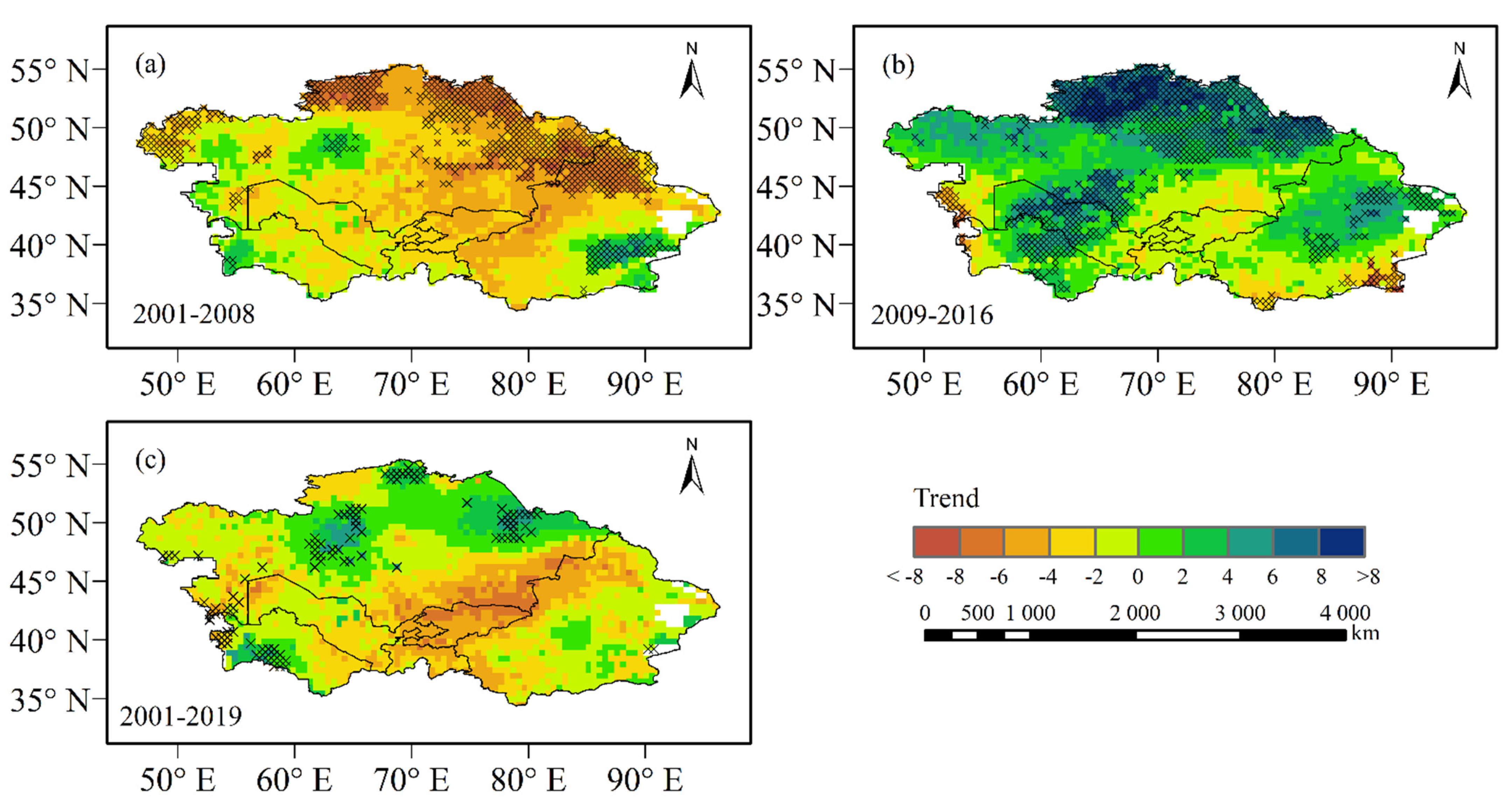
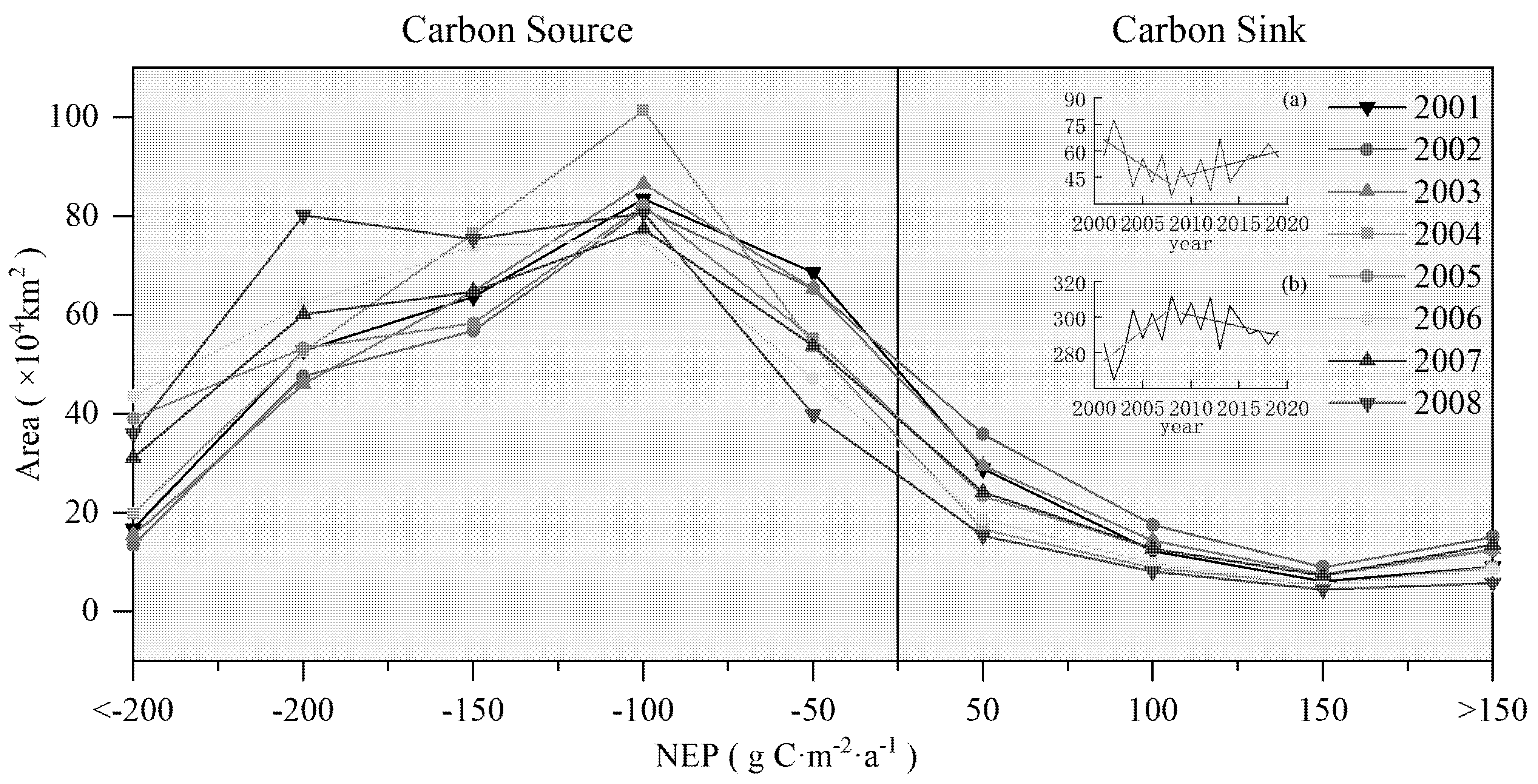
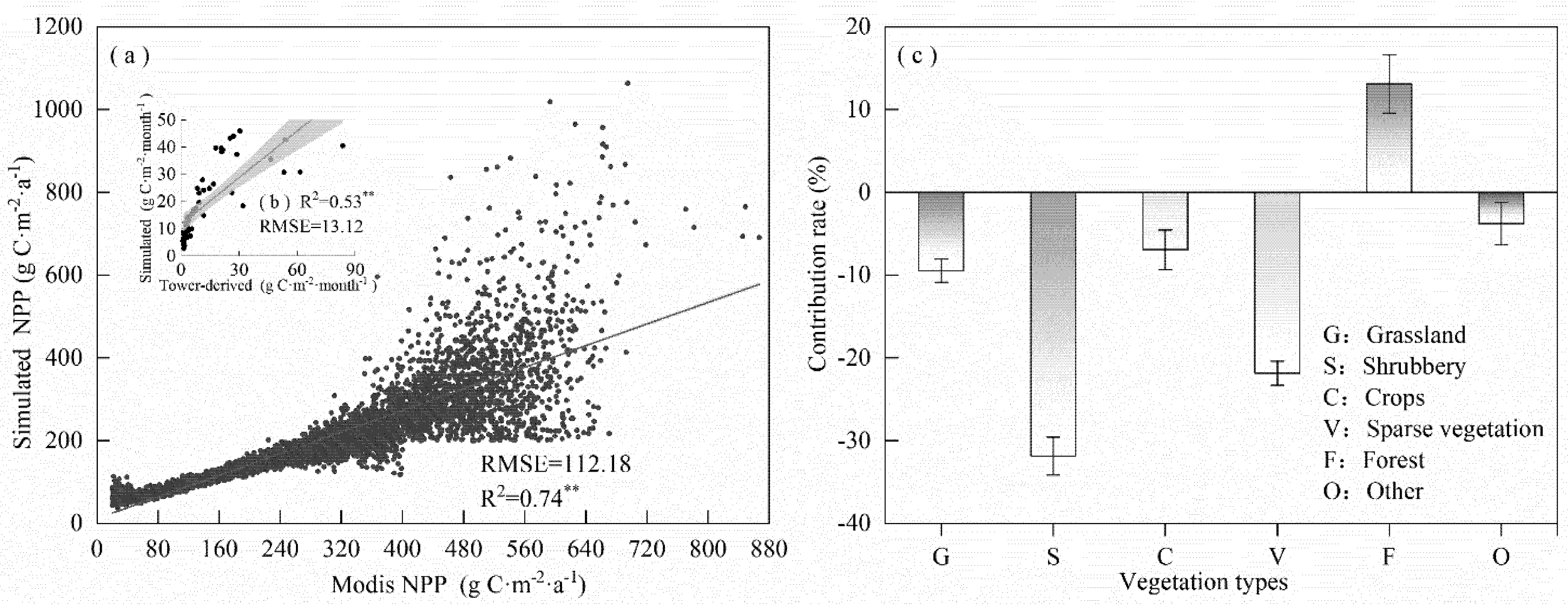
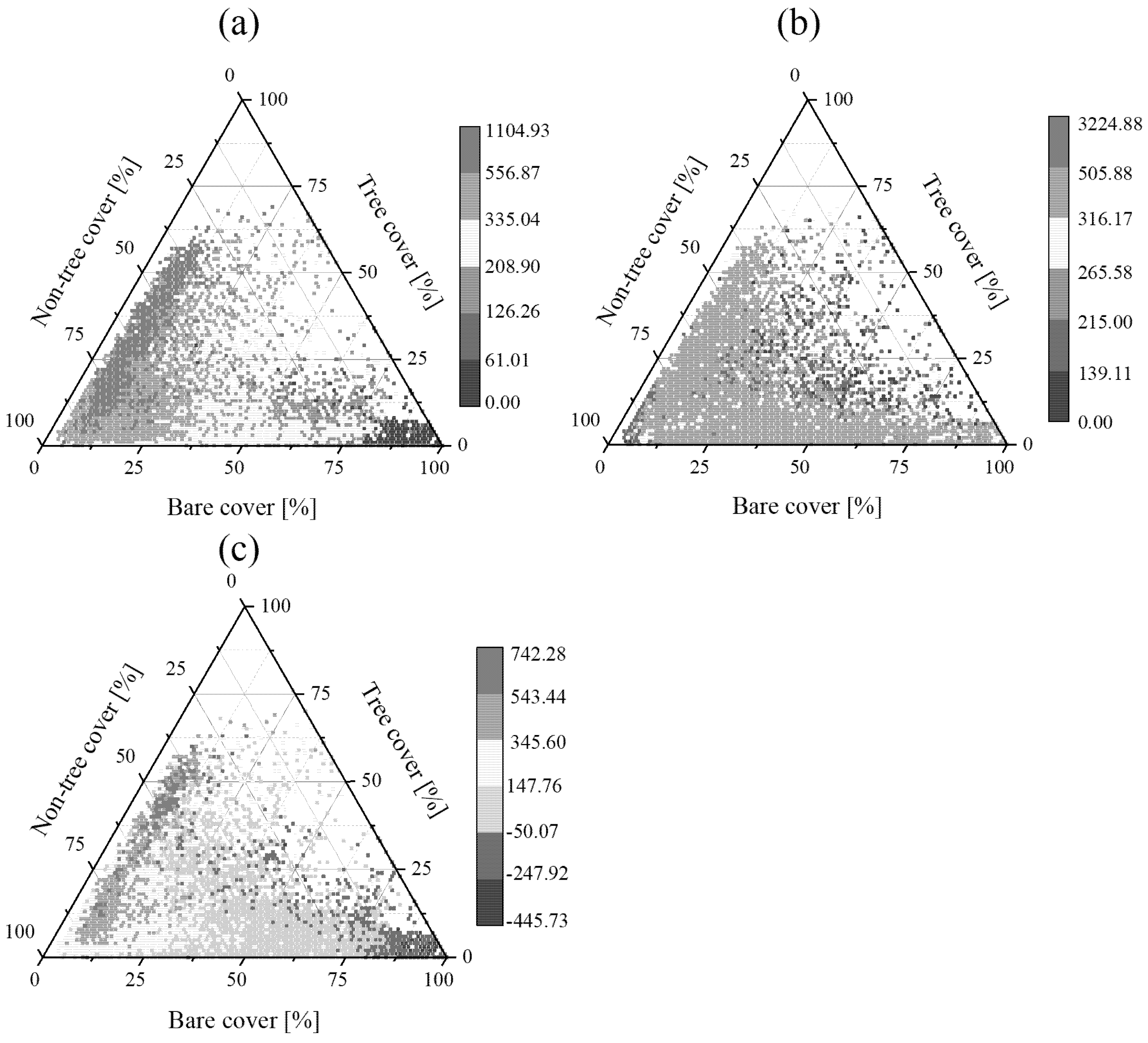
Publisher’s Note: MDPI stays neutral with regard to jurisdictional claims in published maps and institutional affiliations. |
© 2021 by the authors. Licensee MDPI, Basel, Switzerland. This article is an open access article distributed under the terms and conditions of the Creative Commons Attribution (CC BY) license (https://creativecommons.org/licenses/by/4.0/).
Share and Cite
Zhang, J.; Hao, X.; Hao, H.; Fan, X.; Li, Y. Climate Change Decreased Net Ecosystem Productivity in the Arid Region of Central Asia. Remote Sens. 2021, 13, 4449. https://doi.org/10.3390/rs13214449
Zhang J, Hao X, Hao H, Fan X, Li Y. Climate Change Decreased Net Ecosystem Productivity in the Arid Region of Central Asia. Remote Sensing. 2021; 13(21):4449. https://doi.org/10.3390/rs13214449
Chicago/Turabian StyleZhang, Jingjing, Xingming Hao, Haichao Hao, Xue Fan, and Yuanhang Li. 2021. "Climate Change Decreased Net Ecosystem Productivity in the Arid Region of Central Asia" Remote Sensing 13, no. 21: 4449. https://doi.org/10.3390/rs13214449






